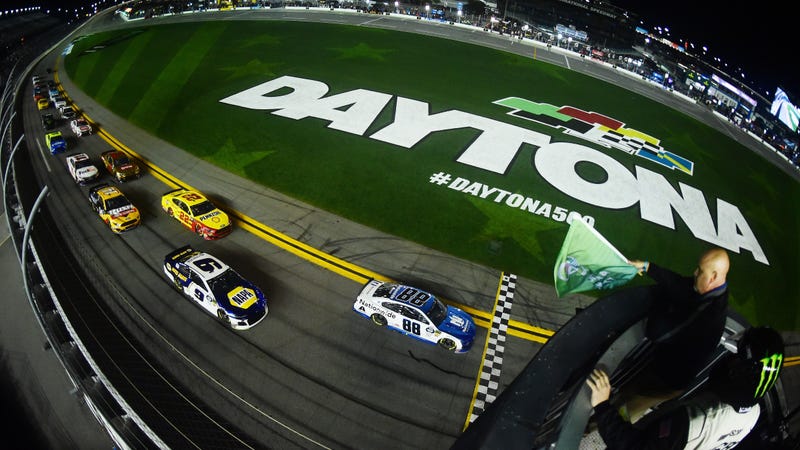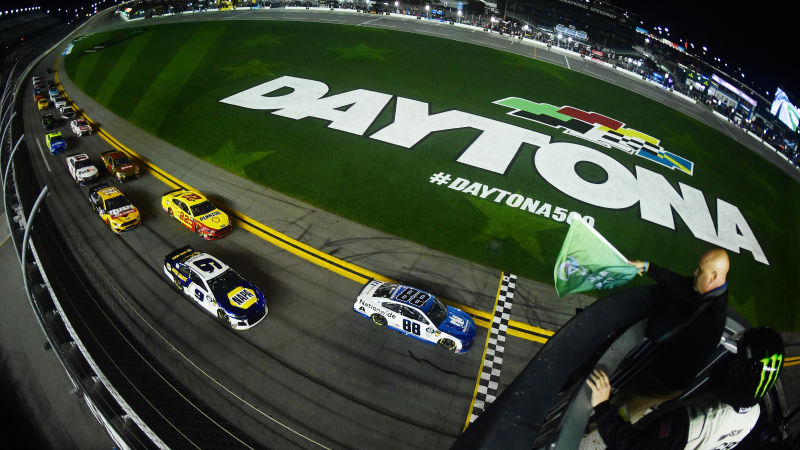
NASCAR isn’t as simple as trying to drive in a few hundred circles faster than everyone else, and hasn’t ever been. But that’s been the overarching idea for most of its history, up until the last few years, when rules overhauls introduced segmented races, a near algebraic points system and elimination playoffs.
If you’re planning to tune into the Daytona 500 on Sunday but don’t know how to follow it all, welcome to your handy cheat sheet. We’ll keep this simple—as simple as possible, that is.
How Modern NASCAR Races Work
NASCAR’s big rules overhauls in the past few years have mainly been for its top three national series, the Monster Energy Cup Series, Xfinity Series and Gander Outdoors Truck Series,and they’ve drastically changed how the sport works.
Rather than running laps and letting cautions fall where they may, each regular points race in NASCAR’s top three national series now has at least two planned caution periods due to “stages.”Stages came around for the start of the 2017 season,separating regular points races into segments.
Advertisement
In most points races, there’s a stage break after about the first quarter of the event and then around halfway through it. During the stage break, the race goes under caution, the field gets bunched back up again, and drivers get title points based on where they crossed the line at the end of the stage.
A green-and-white checkered flag ends a stage,a caution period comes after that and clicks away a few extra laps, and then the field goes green again. The only regular event with a fourth stage is the longest race, the Coca-Cola 600 at Charlotte Motor Speedway,which, at 600 miles long, needs the extra break.
Here’s the deal with stages, in graphical format:

Advertisement
Stage lengths vary by race,with some a whole lot closer to the 25/25/50 breakdown than others, but aside from the 600, the last stage is always the longest. NASCAR published stage lengths for every race this year last week.
How the Championship Works
NASCAR’s had some form of postseason in its top Cup Series series for far more than a decade now, with a points reset for drivers who qualify to compete for the title. The lower Xfinity and Truck Series have only had a postseason for a few years,but all of it looks a lot different today.
Advertisement
The Cup Series has 36 races, and the first 26 are the “regular season.” The last 10 are the so-called playoffs, where those who qualify to race for the title then go through elimination rounds to decide the champion. A race win puts an eligible driver automatically into the postseason in any of the top three series,even if their points don’t. It’s just like Monopoly, if jail were the playoffs.
All three series have a different number of available playoff spots,and any spots leftover after the winners take theirs are given to remaining drivers based on where they are in the points standings.The playoffs cap is 16 in the Cup Series,and then the elimination rounds begin to cut the field down.
In every series, the last round is just one race: Homestead-Miami Speedway.The remaining playoff driver who finishes the highest in that event, so long as they don’t get disqualified, wins the title.
Advertisement

In the playoffs, drivers can automatically get to the next round by winning in a current round,and the rest of the spots are filled by points—the same way the playoff contenders are decided at the end of the regular season.
How Points Work
While wins are the biggest focus in NASCAR now, points are still a fallback—especially during the championship stretch, when there are a lot fewer races to potentially win and automatically advance.
Advertisement
Points go out at the end of each stage and the end of the race. The drivers who finish in the top 10 in each stage get regular championship points, and the one who finishes first gets a playoff point.There’s a difference, which we’ll get to later. Here’s how stage points go:

When the race ends, each driver eligible for series points gets at least one. The winner in the Cup Series gets 40 points, second place gets 35, third gets 34, and the number goes down by one from there. Drivers who finish 36th and below get one regular point.The winner of each race gets five playoff points,and playoff points are passed out to the top finishers in the standings at the end of the regular season as well.
Advertisement
Playoff points only matter for those who make the playoffs, and become regular points if a driver is eliminated.They matter because point tallies reset for each round of the playoffsin order to separate playoff drivers from those who don’t make it, meaning a drivers’ points from the regular season no longer matter in the postseason—only playoff points carry over.
That math, if your brain can take all of it in one day, is here.
Disqualifications
For the first time in decades,NASCAR said it will disqualify drivers and teams if they fail post-race inspection this year. That’s compared to doing a whole lot of things to get around the big “DQ” in the past, like taking away every advantage of a victory—points and all—aside from the trophy.
Advertisement
Screwing the rules is something NASCAR teams are fond of, with an executive saying the sanctioning body needs to fix its “culture of cheating” after teams cheated, cheated and cheated some more last year. That’s the entire goal of the disqualifications, which NASCAR avoided for years based on an old mindset of wanting fans to know the winner when they left the track.
NASCAR said it will do a thorough post-race inspection the day of the races in all three series, so that it can confirm the finishing order within two hours of the race ending.If a driver gets disqualified in the inspection, they’ll be dropped to last in the finishing order and lose all of the benefits of their finish—stage points, playoff points and the benefits of a win, like advancing to the playoffs or to the next round of the playoffs.
Modern NASCAR tends to be one big math equation, but like all math equations, the rules get easier to understand in time. But if you’re just in it this weekend for the wrecks or the duty you feel to watch stock cars at Daytona because it’s about as American as the Fourth of July, well, that’s understandable too.
Advertisement
Now, at least, you’ll know a little more about what’s going on.













